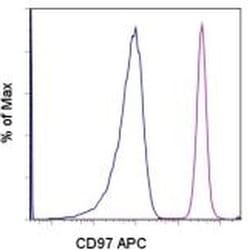Learn More
Invitrogen™ CD97 Monoclonal Antibody (VIM3b), APC, eBioscience™
Mouse Monoclonal Antibody
Supplier: Invitrogen™ 17697942

Description
Description: This VIM3b monoclonal antibody reacts with human CD97, a member of the epidermal growth factor (EGF)-TM7 family of cell surface receptors. Present on a variety of hematopoietic cells, CD97 is most highly expressed on granulocytes and monocytes. CD97 can also be detected on lymphocytes, with T and NK cells expressing higher levels than B cells. Moreover, CD97 expression on T lymphocytes can be induced by stimulation of CD3 and CD28. Studies have demonstrated that CD97 is involved in granulocyte trafficking and T cell activation. CD55, also known as Decay-accelerating factor (DAF), is the ligand of CD97. Due to alternative splicing, CD97 exists as three isoforms with molecular weights of 74, 80, and 86 kDa. The VIM3b monoclonal antibody recognizes each form. Applications Reported: This VIM3b antibody has been reported for use in flow cytometric analysis. Applications Tested: This VIM3b antibody has been pre-titrated and tested by flow cytometric analysis of normal human peripheral blood cells. This can be used at 5 μL (1 μg) per test. A test is defined as the amount (μg) of antibody that will stain a cell sample in a final volume of 100 μL. Cell number should be determined empirically but can range from 10^5 to 10^8 cells/test. Excitation: 633-647 nm; Emission: 660 nm; Laser: Red Laser. Filtration: 0.2 μm post-manufacturing filtered.
CD97 is a G-protein-coupled seven-span transmembrane adhesive receptor that is constitutively expressed on granulocytes and monocytes and rapidly upregulated on T and B cells upon activation. CD97 is produced in alternatively spliced forms and its cellular ligand is CD55 (DAF), which protects various cell types from complement-mediated damage. Interaction of CD97 on leukocytes and CD55 on vessel cells probably facilitate leukocyte activation and migration into the tissues, similarly, CD97 seems to play a role in tumour migration and invasiveness. CD97 is involved in T cell regulation and peripheral granulocyte homeostasis.
Specifications
| CD97 | |
| Monoclonal | |
| 5 μL/Test | |
| PBS with BSA and 0.09% sodium azide; pH 7.2 | |
| P48960 | |
| ADGRE5, CD97 | |
| Affinity chromatography | |
| RUO | |
| 976 | |
| 4°C, store in dark, DO NOT FREEZE! | |
| Liquid |
| Flow Cytometry | |
| VIM3b | |
| APC | |
| ADGRE5 | |
| AA409984; Adgre5; adhesion G protein-coupled receptor E5; Cd97; CD97 antigen; CD97 antigen subunit alpha; CD97 antigen subunit beta; CD97 molecule; EGF-TM7 receptor; leukocyte antigen CD97; seven transmembrane helix receptor; seven-span transmembrane protein; seven-transmembrane, heterodimeric receptor associated with inflammation; TM7LN1 | |
| Mouse | |
| 100 Tests | |
| Primary | |
| Human | |
| Antibody | |
| IgG1 |
The Fisher Scientific Encompass Program offers items which are not part of our distribution portfolio. These products typically do not have pictures or detailed descriptions. However, we are committed to improving your shopping experience. Please use the form below to provide feedback related to the content on this product.
